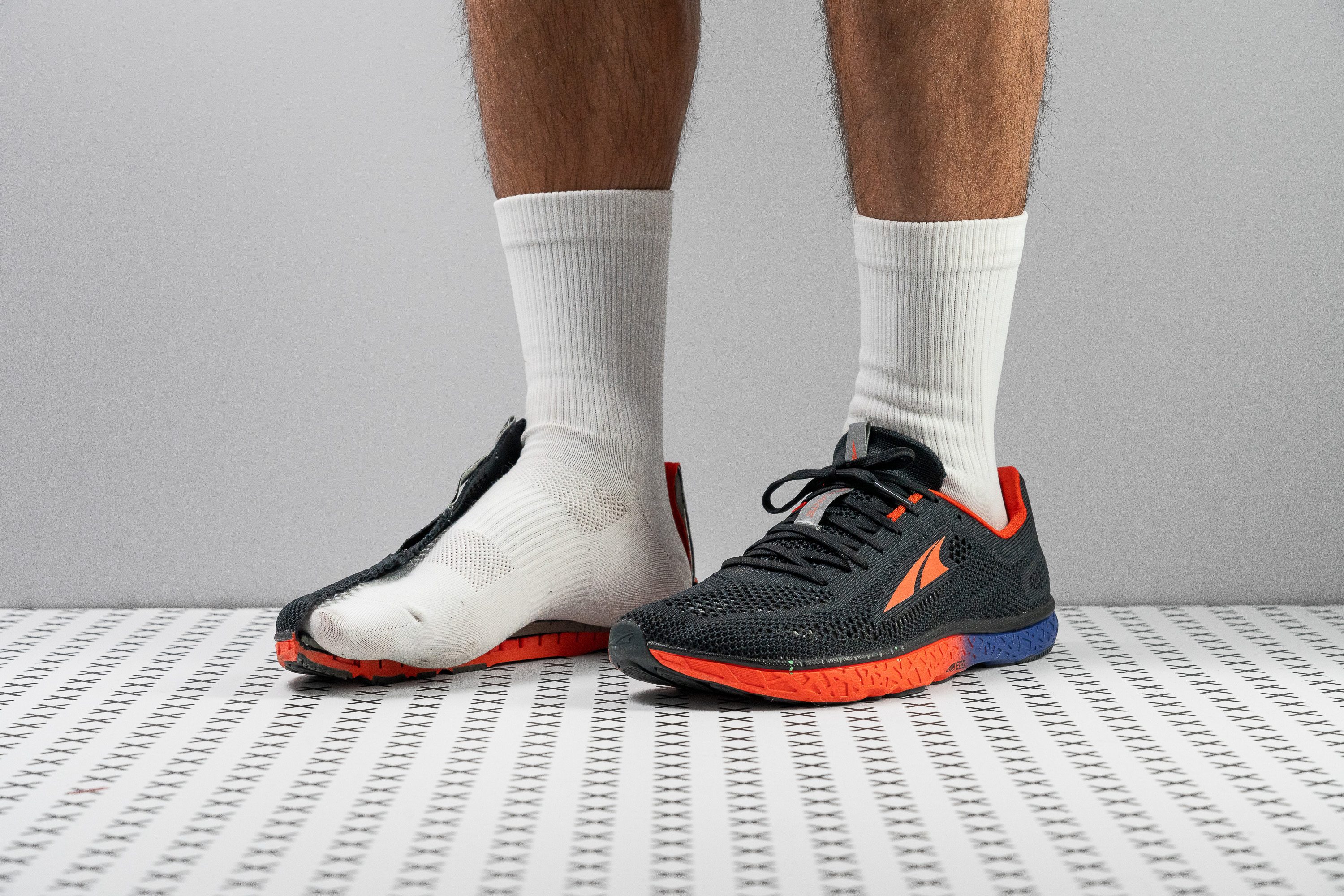Our verdict
- Top pick in best zero drop running shoes (2024)
- Top pick in best Altra running shoes (2024)
Pros
- Durable, breathable upper
- Exceptionally flexible
- Minimalist, natural ride
- Superior grip
- Spacious toebox
- Stable
- Really lightweight
- Authentic zero-drop design
Cons
- Minimal energy return
- Not the best for winter
- Non-gusseted tongue
Audience verdict
- Top 10% in road running shoes
- Top 5% in Altra running shoes
Comparison
The most similar running shoes compared
+ + Add a shoe | |||||
|---|---|---|---|---|---|
| Audience score | 91 Superb! | 87 Great! | 85 Good! | 84 Good! | |
| Price | $140 | $140 | $130 | $120 | |
| Pace | CompetitionTempo | CompetitionTempo | Daily runningTempo | Daily runningTempo | |
| Shock absorption | - | - | - | Moderate | |
| Energy return | - | - | - | Moderate | |
| Traction | - | - | - | Moderate | |
| Arch support | Neutral | Neutral | Neutral | Neutral | |
| Weight lab Weight brand | 7.3 oz / 208g 6.8 oz / 193g | 7.9 oz / 224g 7.9 oz / 224g | 8.3 oz / 235g 10 oz / 283g | 6.8 oz / 194g 6.7 oz / 190g | |
| Lightweight | ✓ | ✓ | ✓ | ✓ | |
| Drop lab Drop brand | 0.5 mm 0.0 mm | 1.1 mm 0.0 mm | 0.4 mm 0.0 mm | 4.4 mm 4.0 mm | |
| Strike pattern | Mid/forefoot | Mid/forefoot | Mid/forefoot | Mid/forefoot | |
| Size | True to size | True to size | Slightly small | Slightly small | |
| Midsole softness | Firm | Balanced | Soft | Balanced | |
| Difference in midsole softness in cold | Small | Normal | Normal | Small | |
| Toebox durability | Good | Good | Decent | Bad | |
| Heel padding durability | Good | Decent | Bad | Good | |
| Outsole durability | Decent | Good | Good | Good | |
| Breathability | Breathable | Breathable | Moderate | Breathable | |
| Width / fit | Medium | Wide | Narrow | Medium | |
| Toebox width | Wide | Wide | Wide | Medium | |
| Stiffness | Moderate | Moderate | Stiff | Flexible | |
| Torsional rigidity | Flexible | Flexible | Flexible | Flexible | |
| Heel counter stiffness | Flexible | Flexible | Flexible | Flexible | |
| Heel lab Heel brand | 19.0 mm 22.0 mm | 22.5 mm 24.0 mm | 28.4 mm 28.0 mm | 27.9 mm 30.0 mm | |
| Forefoot lab Forefoot brand | 18.5 mm 22.0 mm | 21.4 mm 24.0 mm | 28.0 mm 28.0 mm | 23.5 mm 26.0 mm | |
| Widths available | Normal | Normal | Normal | NormalWide | |
| Orthotic friendly | ✓ | ✓ | ✓ | ✓ | |
| Season | SummerAll seasons | SummerAll seasons | All seasons | SummerAll seasons | |
| Removable insole | ✓ | ✓ | ✓ | ✓ | |
| Ranking | #54 Top 9% | #151 Top 41% | #211 Bottom 43% | #239 Bottom 35% | |
| Popularity | #389 Bottom 41% | #248 Bottom 33% | #286 Bottom 23% | #178 Top 48% |
Who should buy
We highly recommend the Escalante Racer from Altra for:
- Minimalist enthusiasts seeking a zero-drop shoe that delivers a grounded and responsive running experience.
- Altra fans looking for a flexible, lightweight option perfect for tempo runs.
- Runners who prefer a low-stack, natural-feel shoe over the more common maximalist models.

Who should NOT buy
We believe that the Escalante Racer is best suited for runners with strong calves and feet accustomed to zero-drop footwear with minimal cushioning.
If this doesn't describe you, we suggest exploring alternatives like the Nike Streakfly or the New Balance FuelCell Rebel v4—both offer more cushioning and a higher drop, making them more forgiving options.
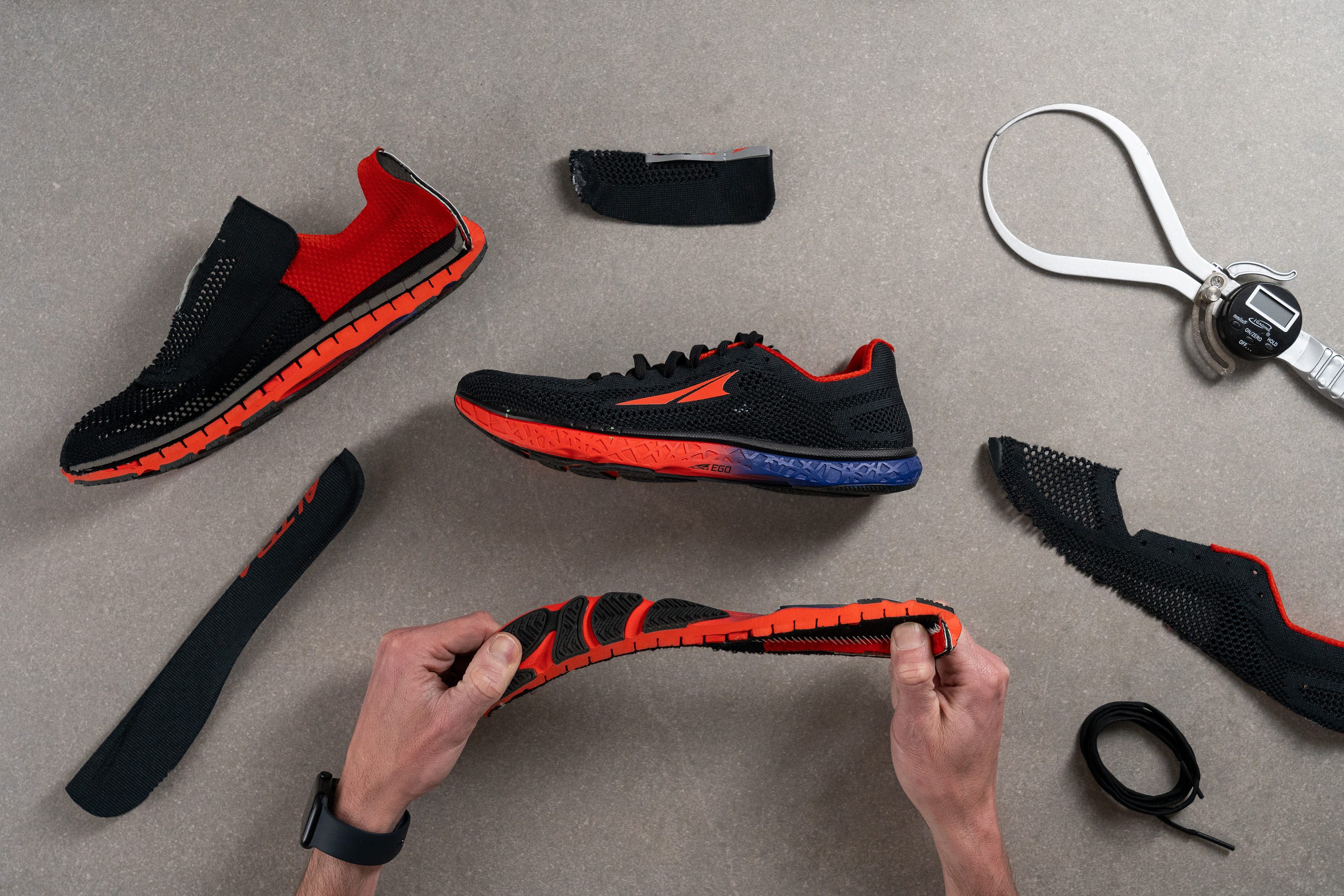
Furthermore, we do not recommend the Escalante Racer for adding significant daily miles due to its lack of foam. For runners looking for an Altra shoe better suited for everyday use, we recommend checking out the Altra VIA Olympus 2. We found it offers a real zero-drop experience but adding a ton of cushioning underfoot.
Cushioning
Heel stack
Anyone examining this shoe will notice that it is a stark contrast to today's popular maximalist designs like the ASICS Superblast. It's actually the exact opposite, featuring a very thin midsole that aims to connect you with the ground rather than isolate you from it.
With its 19.0-mm stack height, those seeking substantial cushioning might find this shoe unsuitable. However, fans of a more grounded and natural feel—where your feet and legs are truly working—will find the Escalante Racer to be exceptionally rewarding.

| Escalante Racer | 19.0 mm |
| Average | 34.8 mm |
Forefoot stack
We measured the forefoot at 18.5 mm, which is nearly identical to the heel's stack height, deviating just 0.5 mm likely due to slight compressions or manufacturing tolerances.
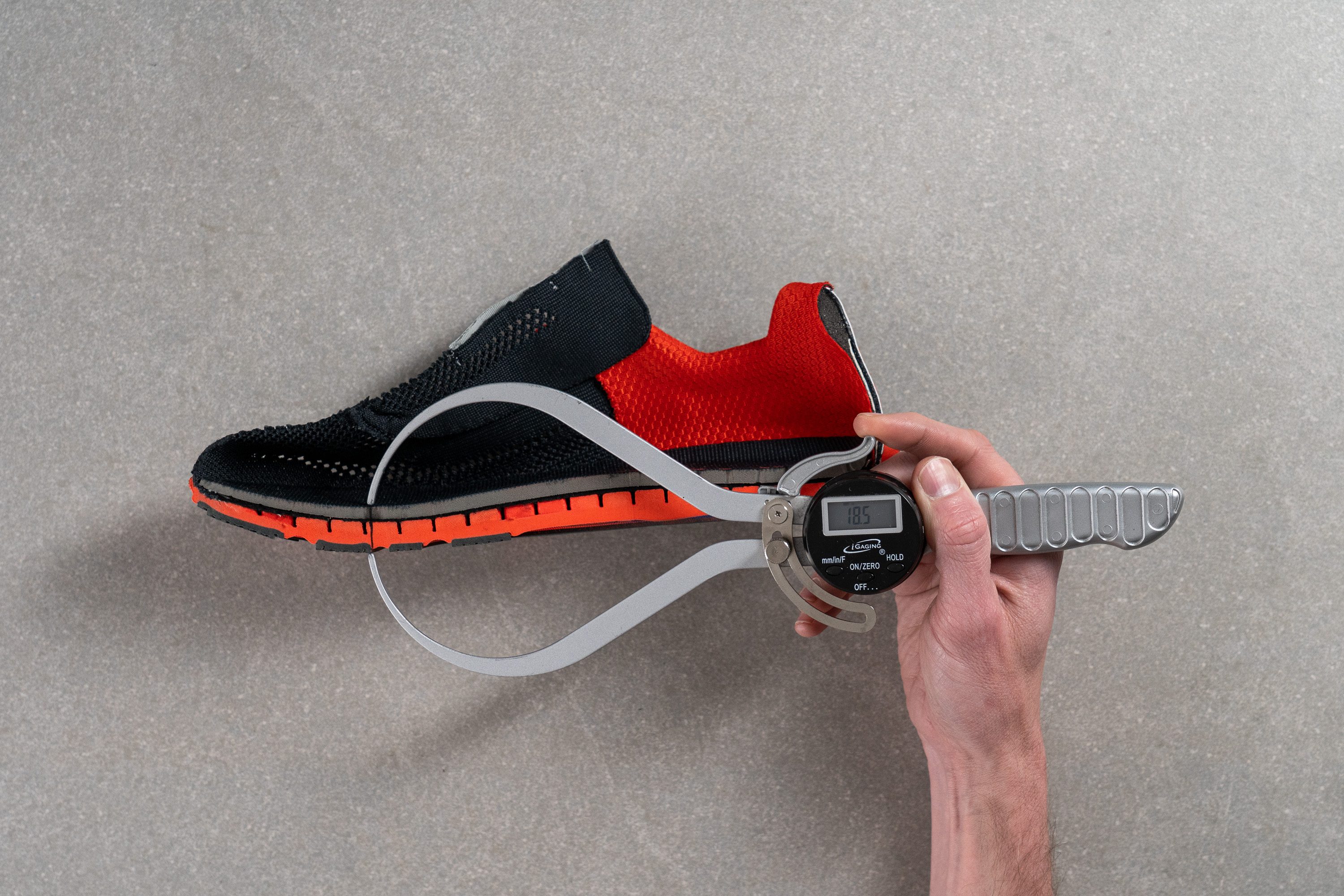
| Escalante Racer | 18.5 mm |
| Average | 26.2 mm |
Drop
The slight 0.5 mm deviation we noted is naturally due to the shoe's zero-drop, minimalist design.
Although it doesn't achieve a perfect 0-mm drop, it comes much closer than most shoes, which typically show larger deviations from their stated drop.
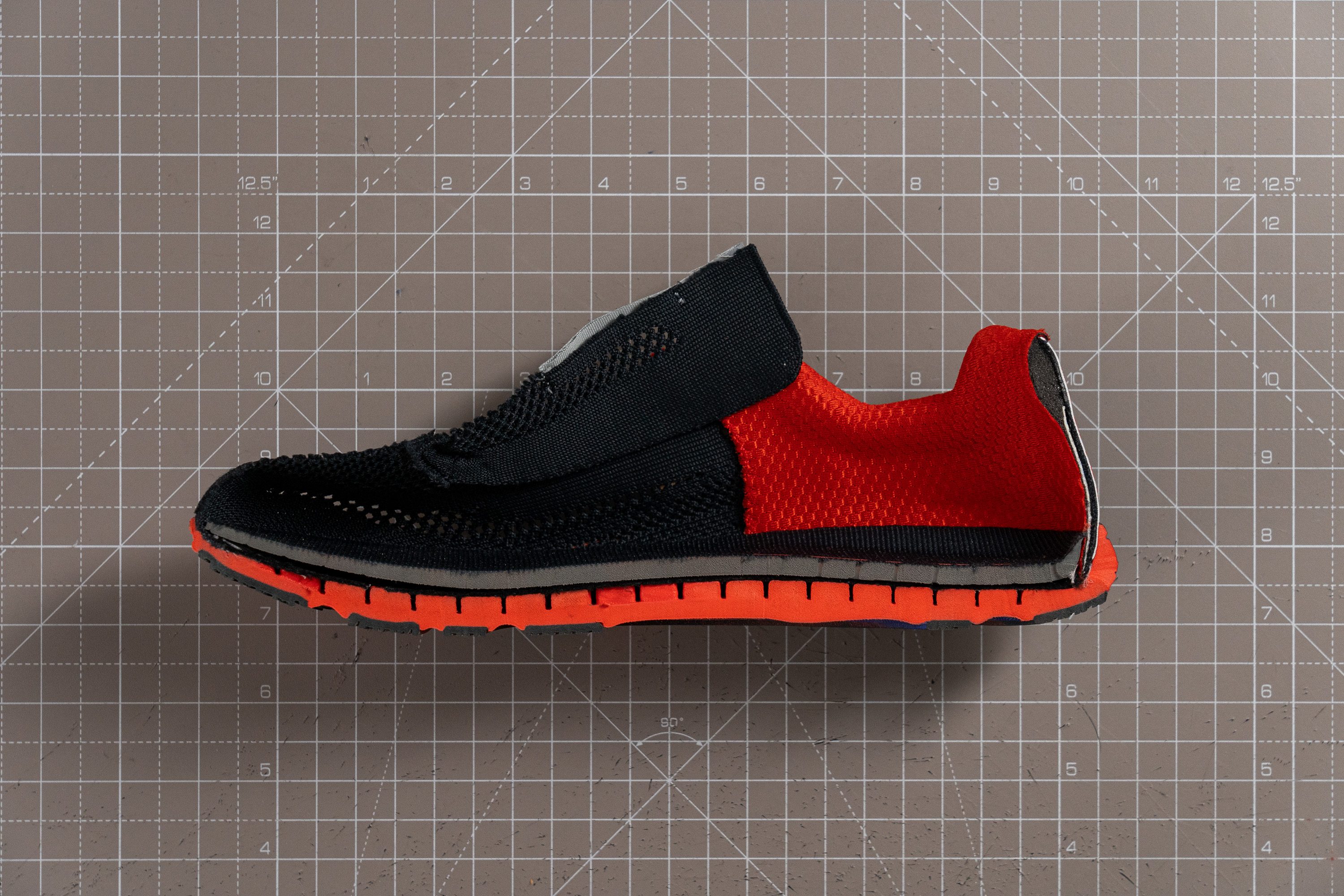
| Escalante Racer | 0.5 mm |
| Average | 8.6 mm |
Midsole softness
Moving to the midsole, we discovered that Altra employs its TPU-based EGO foam combined with InnerFlex technology, which enhances the foam's natural flexing ability to better suit the feet.
Our Shore A durometer testing gave a reading of 30.8 HA, confirming our observations during the test runs—it's definitely a shoe designed for those who prefer a firm feel underfoot.
We must remember that this shoe has barely 2 centimeters of separation between the feet and the ground. Opting for softer, compliant formulations could lead to excessive compression with each stride, which would not be ideal.
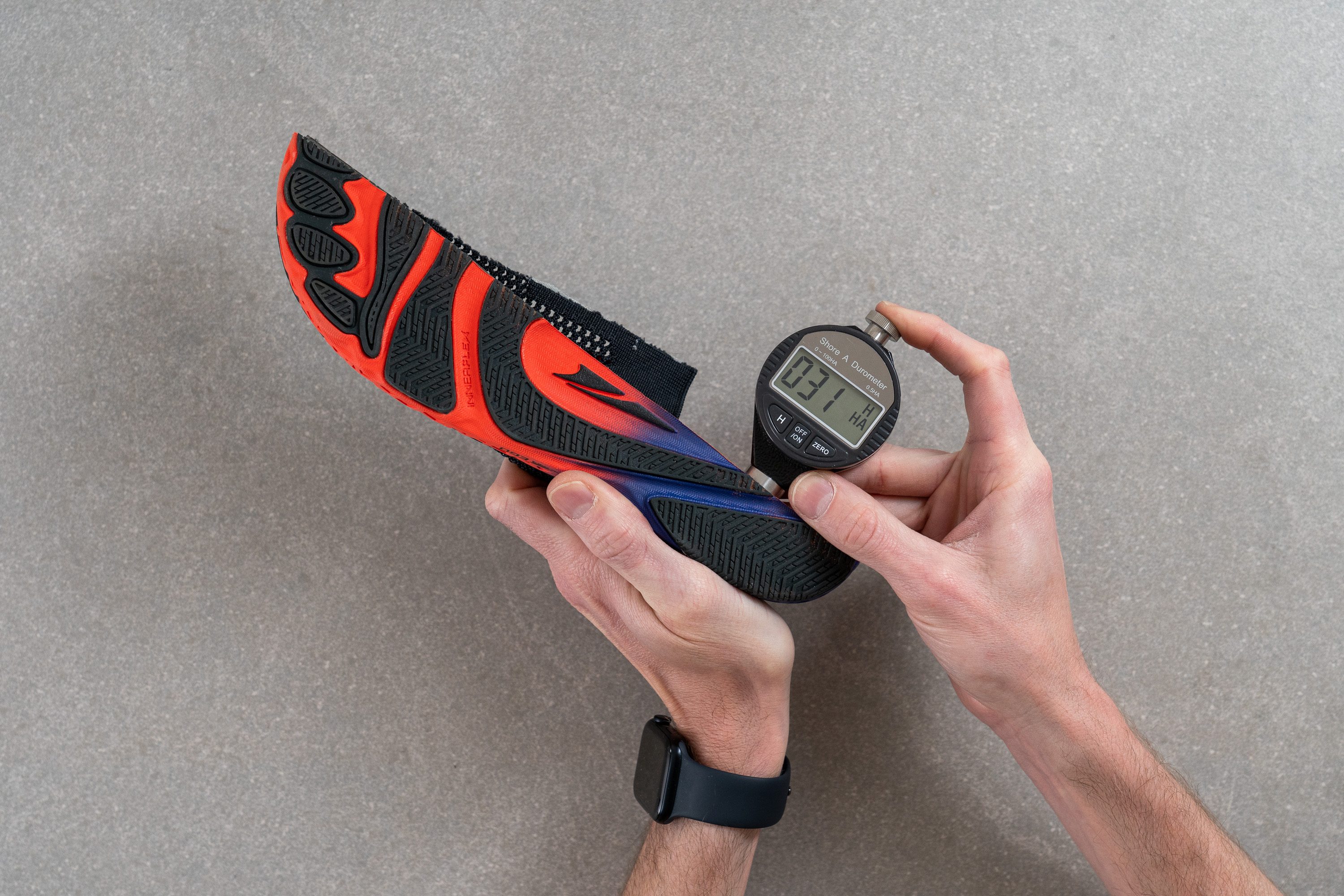
| Escalante Racer | 30.8 HA |
| Average | 20.4 HA |
Rocker
Heel-to-toe rocker? NO!
The Escalante Racer is dedicated to delivering a pure, natural running experience—adding a rockered shape would completely alter that. We found this shoe is pancake flat, really making our feet engage and work hard.
Size and fit
Size
Altra Escalante Racer fits true to size (17 votes).
Toebox width - widest part
In our lab, we measured the widest part of the toebox at 101.9 mm, confirming a wide and roomy fit that's typical of an Altra shoe, just as we anticipated. This design ensures comfort for nearly all foot types.

This test follows an older methodology, which is why you don't see recently tested shoes in the chart. Results from different methodologies can not be compared.
| Escalante Racer | 101.9 mm |
| Average | 98.5 mm |
Toebox width - big toe
One measurement we always look forward to with Altra shoes is the width at the big toe area, because of its FootShape proprietary design.

Indeed, it impressed us once again, measuring a generous 92.5 mm. This substantial width is precisely why the shoe feels incredibly roomy—a perfect fit for those concerned about toe splay or those with square-shaped feet.
This design may not look super cool, but it's a dream come true for those who struggle in regular toeboxes.
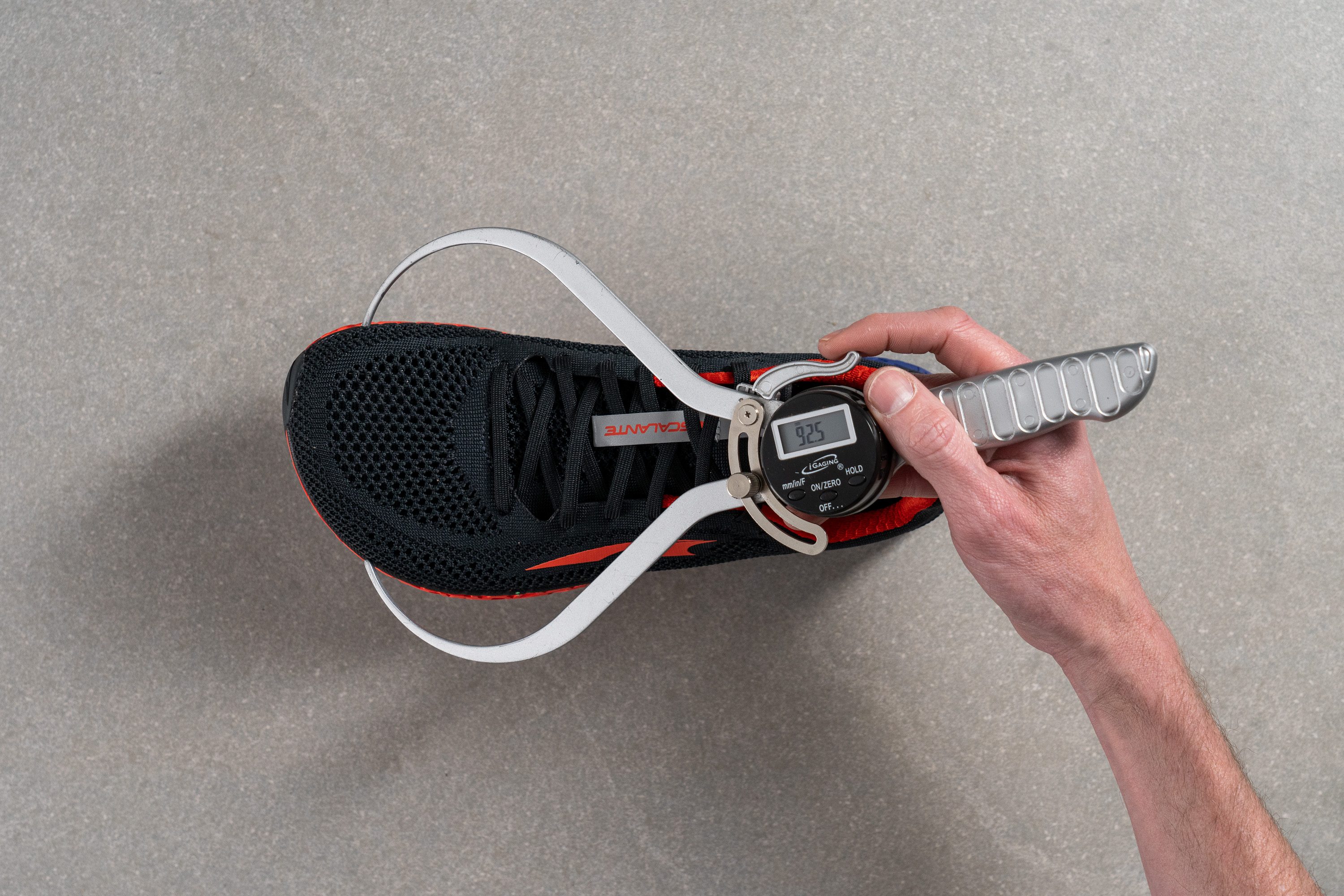
This test follows an older methodology, which is why you don't see recently tested shoes in the chart. Results from different methodologies can not be compared.
| Escalante Racer | 92.5 mm |
| Average | 78.4 mm |
Flexibility / Stiffness
The definitive test of the Escalante Racer's minimalist, ultra-flexible design came with our 90-degree bend test.
We only needed to apply 10.9N of force, which confirms that the shoe flexes seamlessly in every stride. This bends-like-a-yogi flexibility is truly amazing!
This test follows an older methodology, which is why you don't see recently tested shoes in the chart. Results from different methodologies can not be compared.
| Escalante Racer | 10.9N |
| Average | 28.1N |
Stiffness in cold (%)
Under cold temperatures, it becomes 26.4% stiffer, which slightly diminishes the overall flexible feel, but the change is barely noticeable unless it's really, really cold outside.
| Escalante Racer | 26% |
| Average | 33% |
Weight
We just talked about lightness, and the Escalante Racer truly embodies this feature.
Weighing in at just 7.3 oz or 208g, this shoe feels almost invisible on your feet, particularly if you're accustomed to heavier shoes for your daily training sessions.
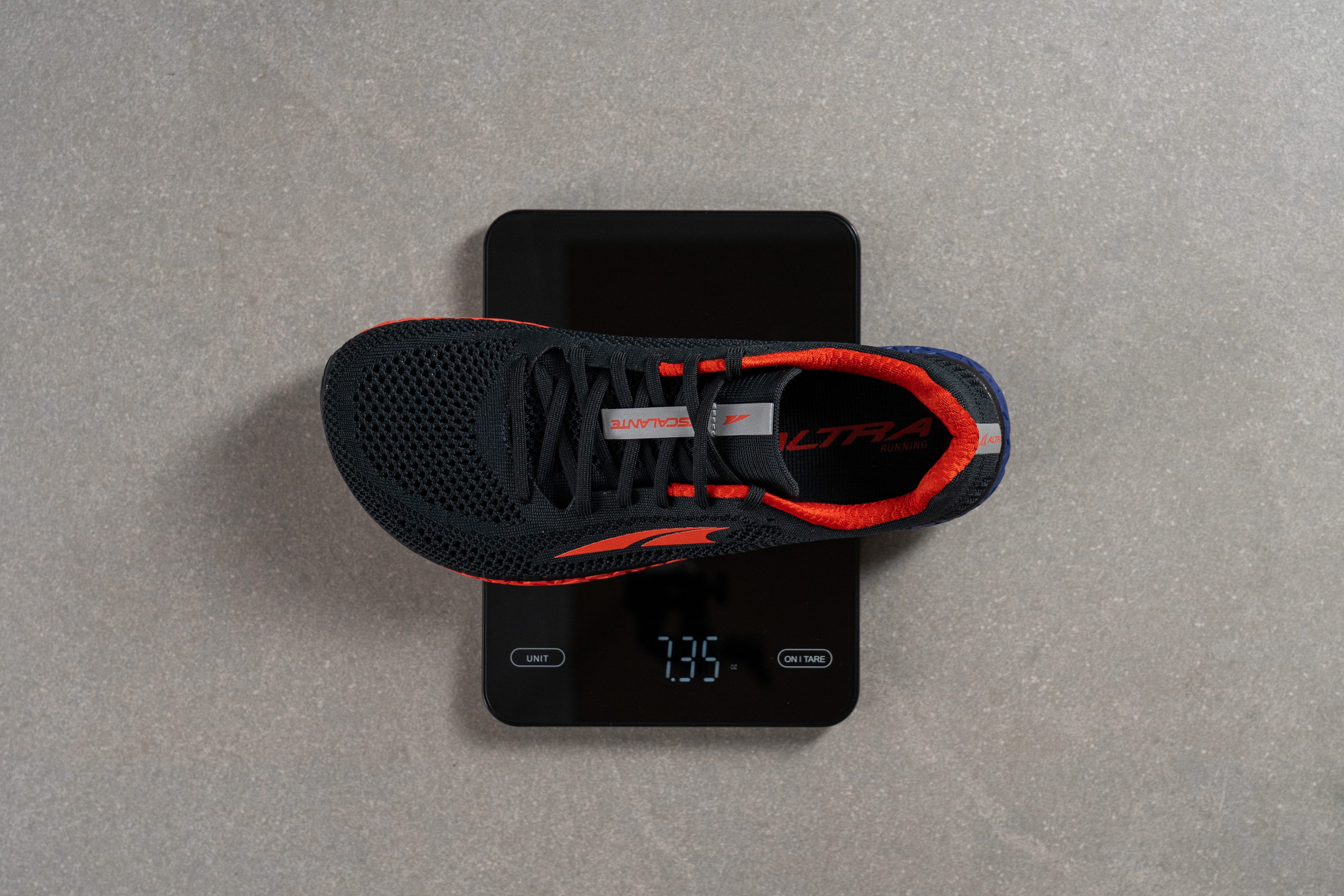
| Escalante Racer | 7.3 oz (208g) |
| Average | 9.3 oz (264g) |
Breathability
Our first assessment of the Escalante Racer's breathability began with our smoke test, where the knit upper truly excelled, earning a perfect score of 5 out of 5 for its exceptional ventilation.
To better understand where the shoe is most breathable, we moved the cut-in-half shoe over a powerful light. This revealed all the ventilation holes clearly, demonstrating that the midfoot also enjoys fantastic airflow—an impressive feature.
Previously, we noticed significant gaps between the threads in the knit and wanted a closer look.
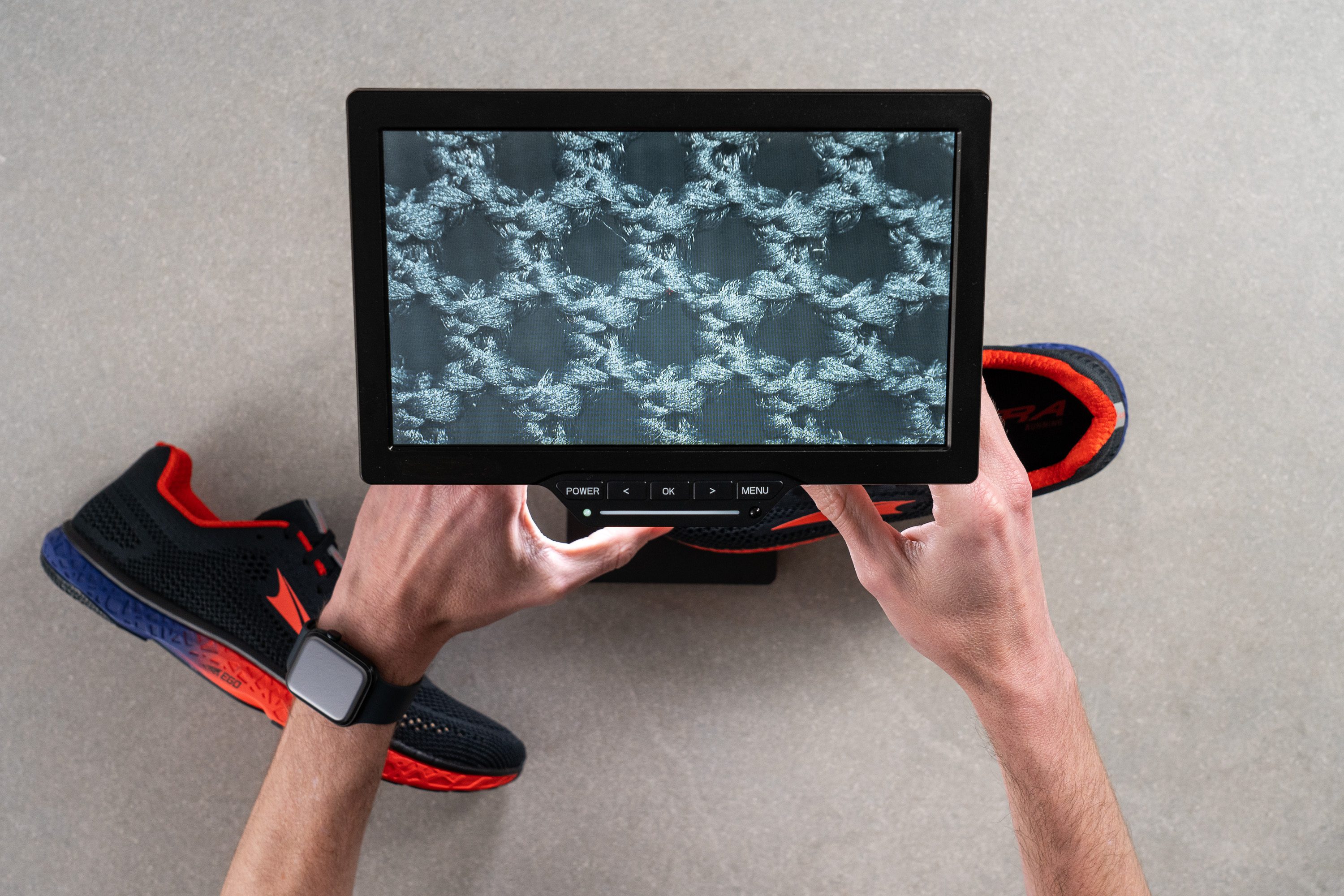
Using a microscope, we indeed discovered very large holes that allow air to pass through effortlessly, making this shoe outstanding for hot summer runs.

Finally, upon closely examining the Escalante Racer's upper, we felt the knit pleasant to the touch and stretchy, although it's not focused on comfort at all.
| Escalante Racer | 5 |
| Average | 3.7 |
Stability
Lateral stability test
The Escalante Racer brings you closer to the ground with its low stack height, offering solid stability for neutral runners and even those with mild pronation.
We found it consistently supportive across various paces, maintaining a natural running feel without any intrusiveness. And it achieves this without guide rails, plates, TPU inserts, or any additional support stuff.
Torsional rigidity
Given its minimalist, flexible approach, we anticipated rating the Escalante Racer a 1 out of 5 in this test, and indeed, that's the score it received.
We were able to twist it effortlessly, encountering almost no resistance!
| Escalante Racer | 1 |
| Average | 3.5 |
Heel counter stiffness
The heel counter is subtly integrated, offering some stiffness (rated 2 out of 5 in the lab) to add a bit of structure and stability in the rearfoot.
We found this to be a smart choice, as it enhances support without compromising the shoe's minimalist feel.
| Escalante Racer | 2 |
| Average | 2.9 |
Midsole width - forefoot
We began by measuring the midsole at the forefoot, which came to 113.3 mm. This dimension is fairly standard, and seems to us like a no-risk approach from Altra.
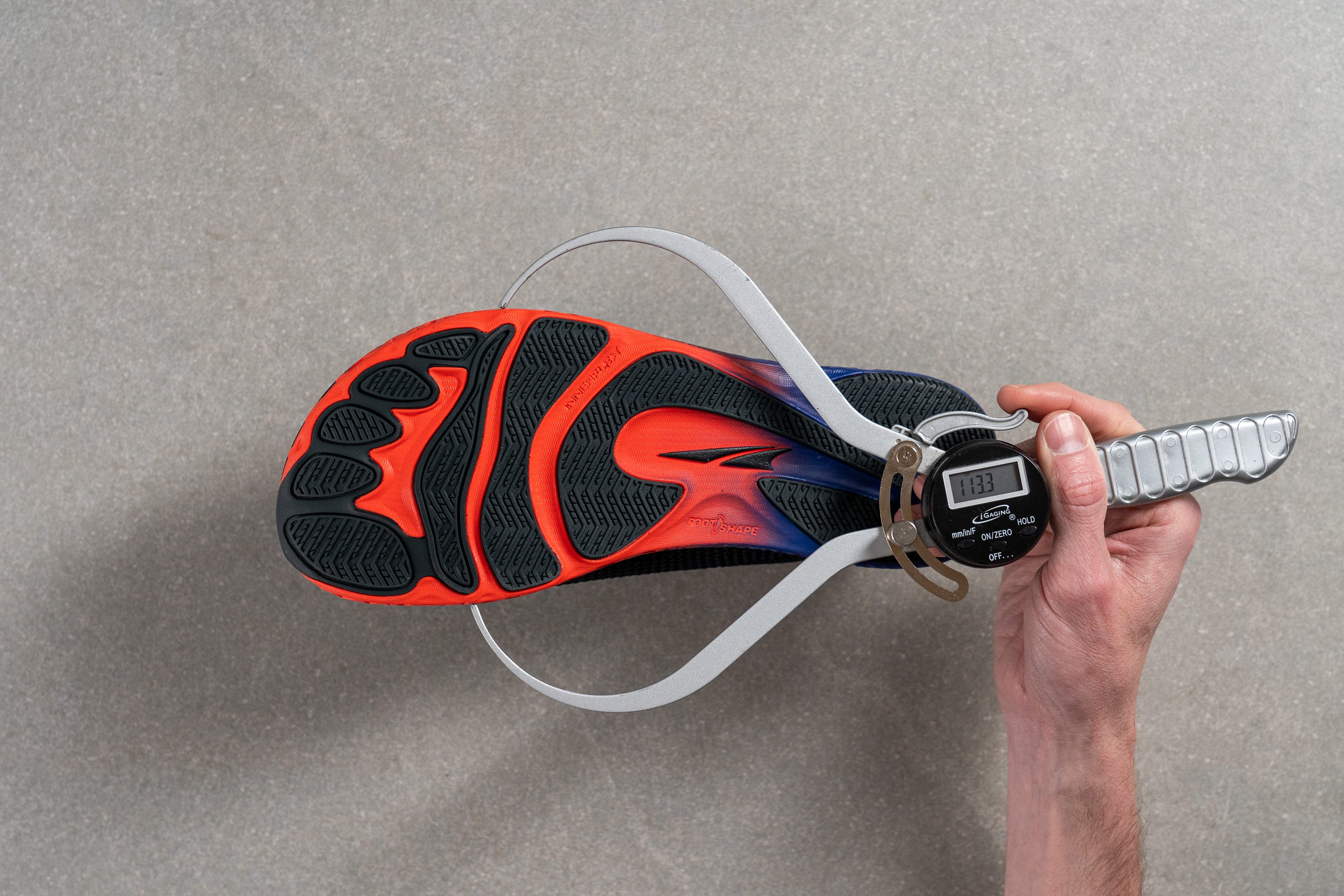
| Escalante Racer | 113.3 mm |
| Average | 114.4 mm |
Midsole width - heel
On the other hand, the heel is quite narrow at just 78.6 mm.
However, it's important to remember that we're dealing with a zero-drop shoe designed to encourage forefoot striking. Adding a wider heel would only increase the weight and make the shoe feel bulkier.
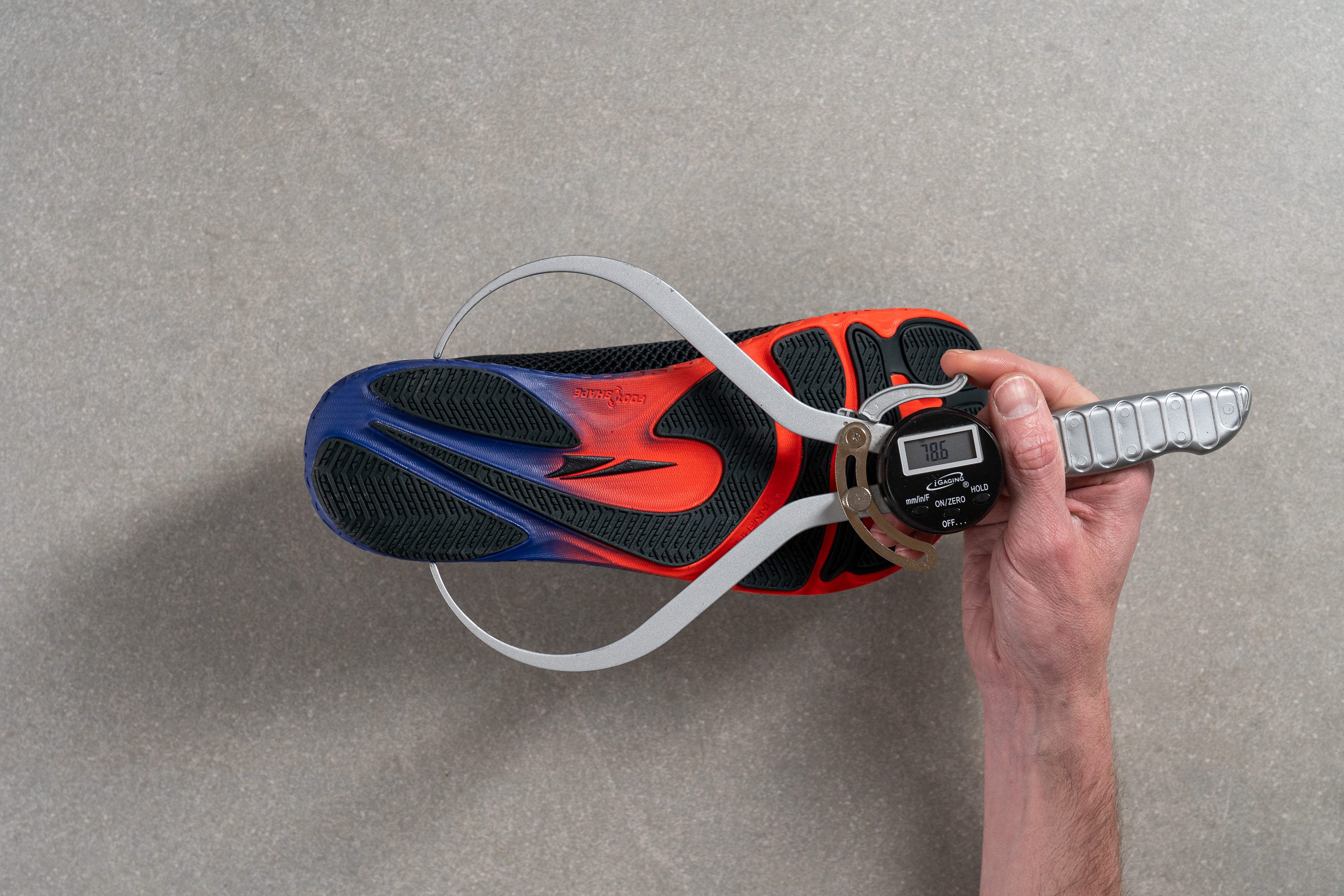
| Escalante Racer | 78.6 mm |
| Average | 90.7 mm |
Durability
Toebox durability
The Altra Escalante Racer seemed set for a challenging outcome in our toebox durability test, given its two features prone to issues—numerous ventilation holes and a knit fabric instead of the tougher engineered mesh.
However, we must applaud Altra for surpassing our expectations in this rigorous test, impressively scoring a 4 out of 5.
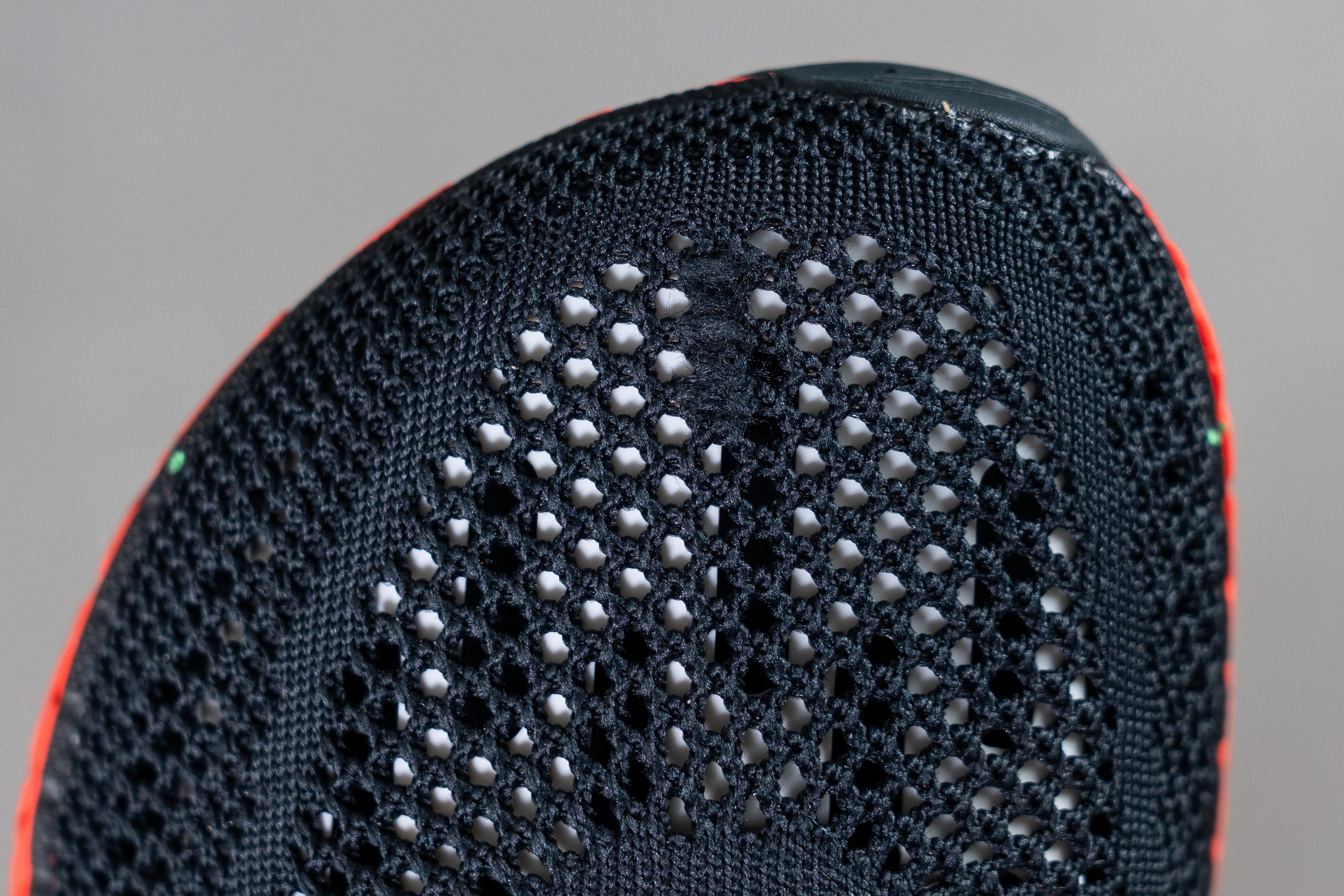
| Escalante Racer | 4 |
| Average | 2.6 |
Heel padding durability
With our excitement sky-high, we continued using the Dremel, this time concentrating on the heel padding. Same specs (3.2N @ 5K RPM) too.
The outcome was equally impressive, scoring a 4 out of 5. This ensures that even for those who tend to wear down their shoes in the Achilles area, this shoe will hold up well.
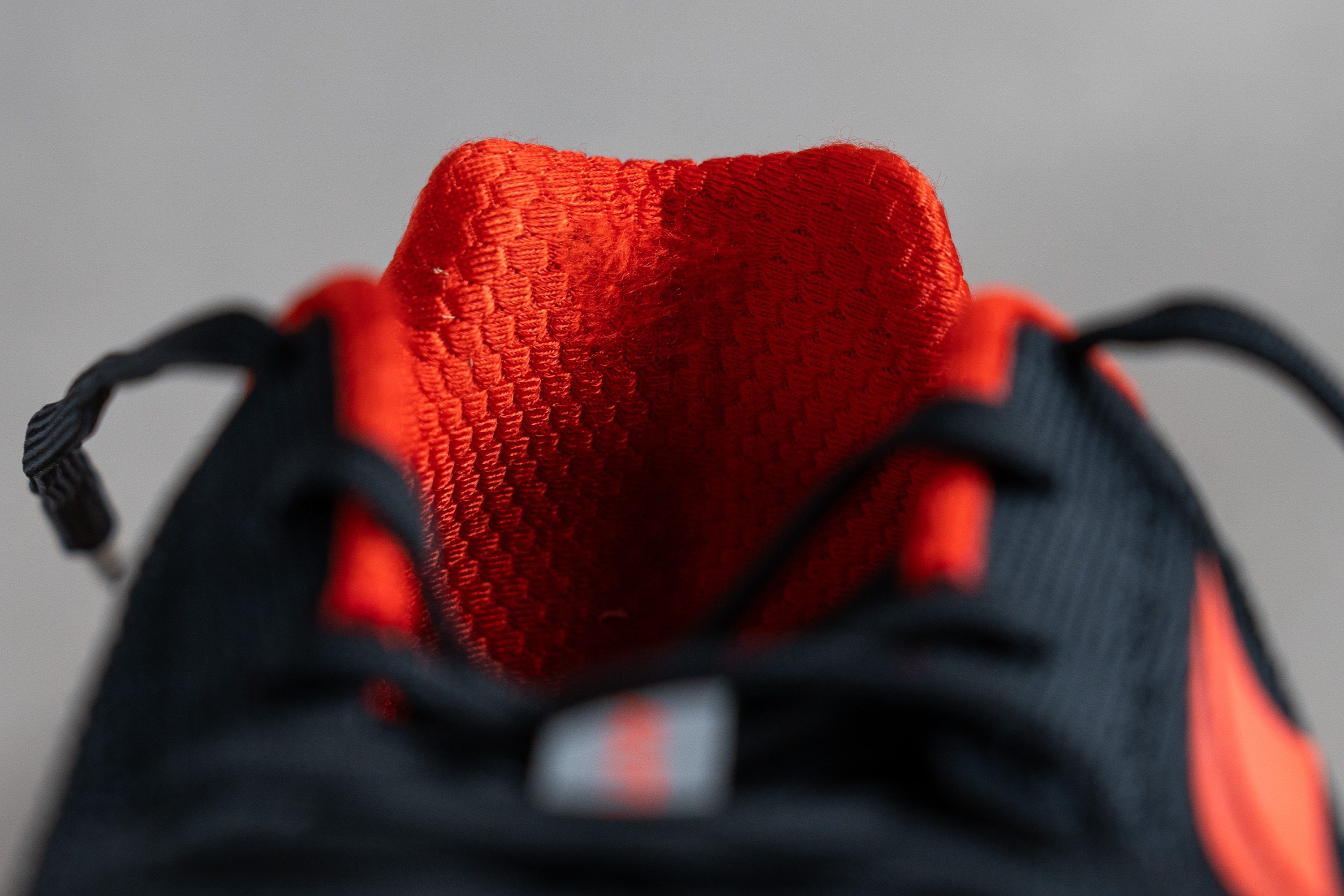
| Escalante Racer | 4 |
| Average | 3.4 |
Outsole hardness
Shifting our focus to the outsole, we began by testing the rubber's hardness, which registered at 75.6 HC.
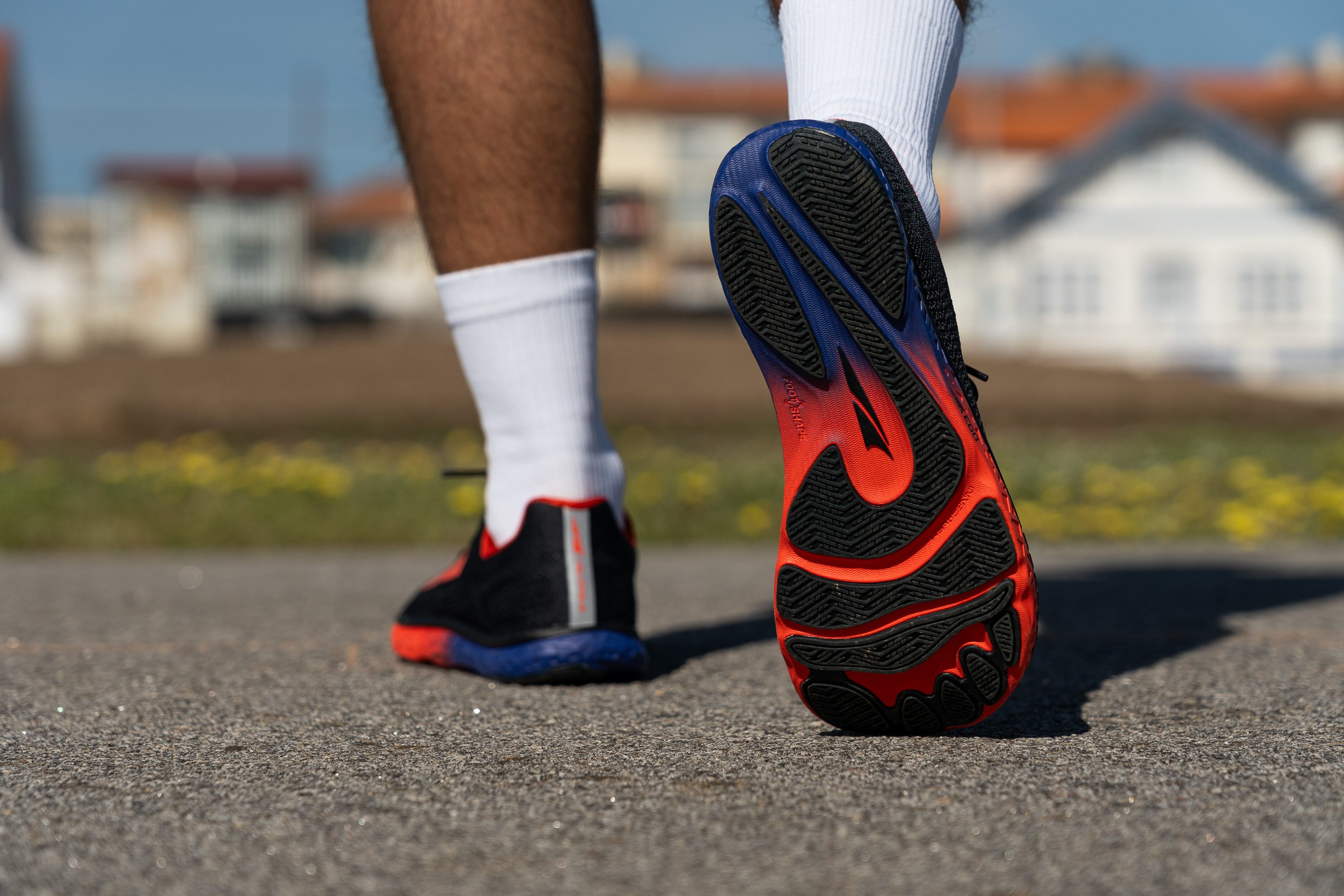
This moderately soft consistency enhances grip, which is beneficial for traction, though it might raise some concerns regarding its longevity.
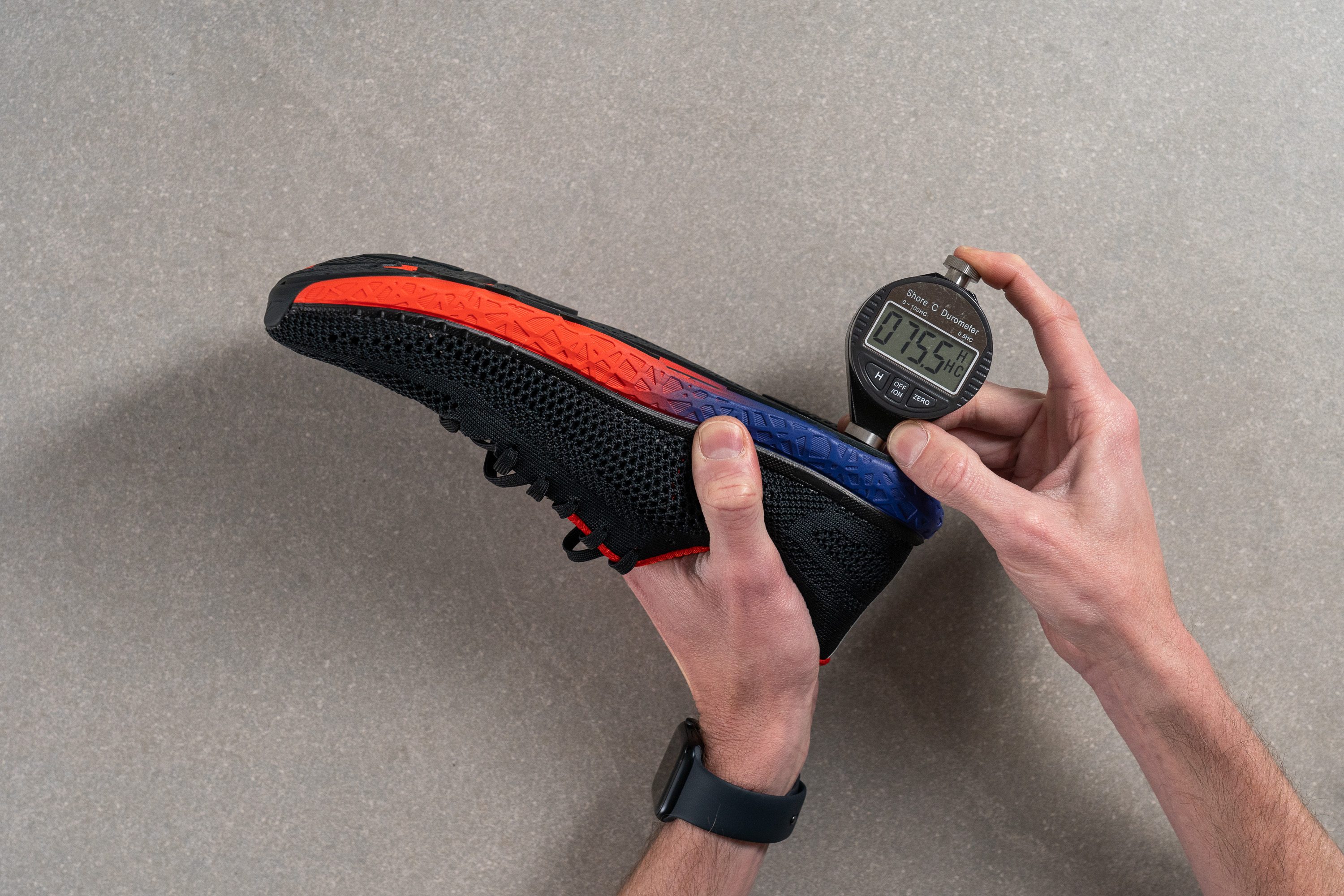
| Escalante Racer | 75.6 HC |
| Average | 79.2 HC |
Outsole durability
We fired up the Dremel for the last time with the Escalante Racer.
After using the tool, we observed a 1.1-mm indentation. While this result isn't alarming and aligns well with our earlier findings, we still anticipate that this rubber might not endure as long as that of a more durable road daily trainer.
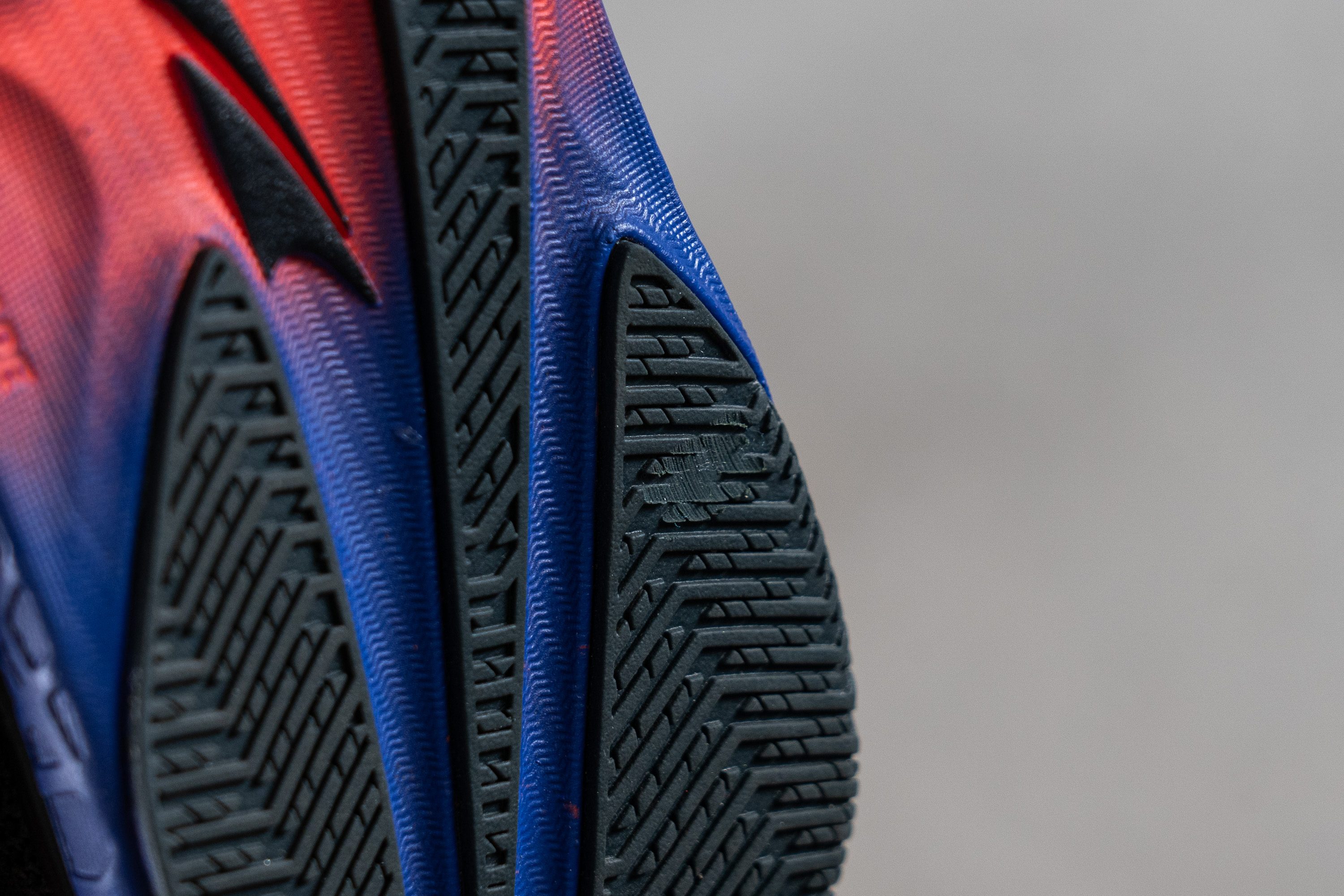
| Escalante Racer | 1.1 mm |
| Average | 1.1 mm |
Outsole thickness
Finally, we measured the outsole using our vernier calipers and recorded a thickness of 2.4 mm.
This is relatively thin compared to most shoes, but it’s an ideal choice for a shoe designed for speed and lightness. It’s a trade-off—you can’t have everything in one shoe!
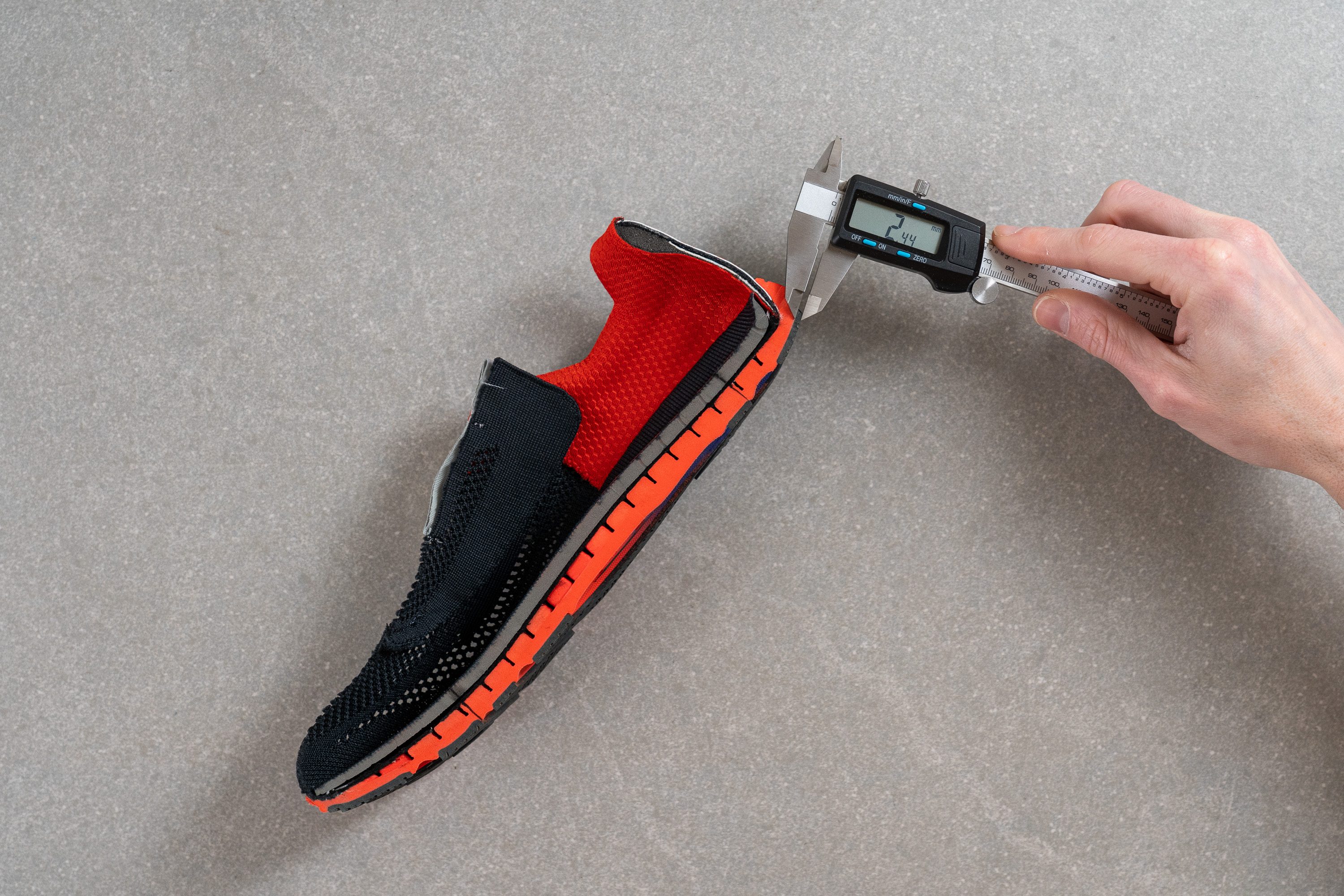
| Escalante Racer | 2.4 mm |
| Average | 3.2 mm |
Misc
Insole thickness
The insole is exceptionally cushioned at 5.7 mm, which might be even a bit too much for this shoe.
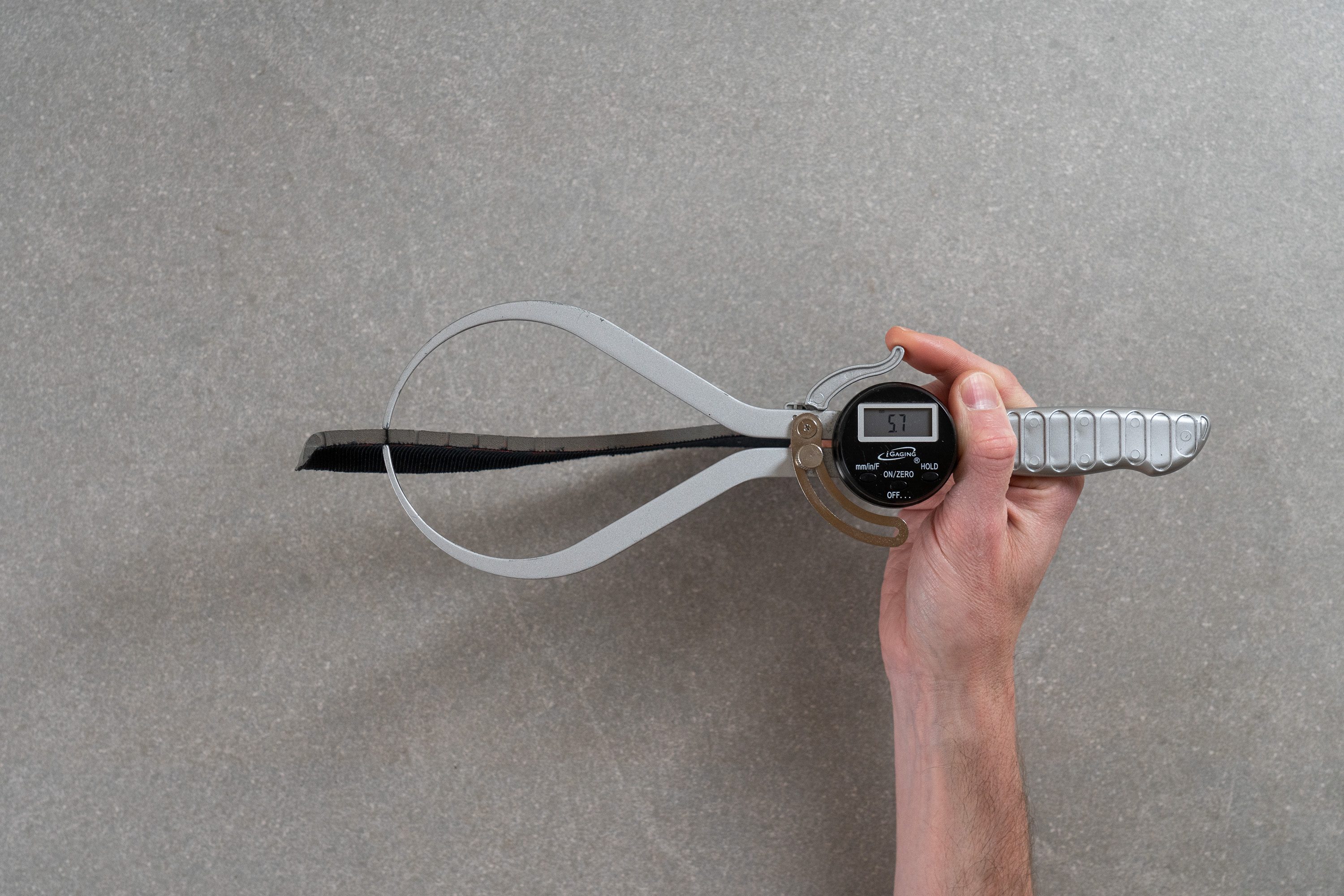
| Escalante Racer | 5.7 mm |
| Average | 4.5 mm |
Removable insole
We found that the footbed in the Escalante Racer is not fixed, which allows you to swap it. However, due to the unique shape of the toebox, we think that finding a replacement may be more challenging than you'd expect.
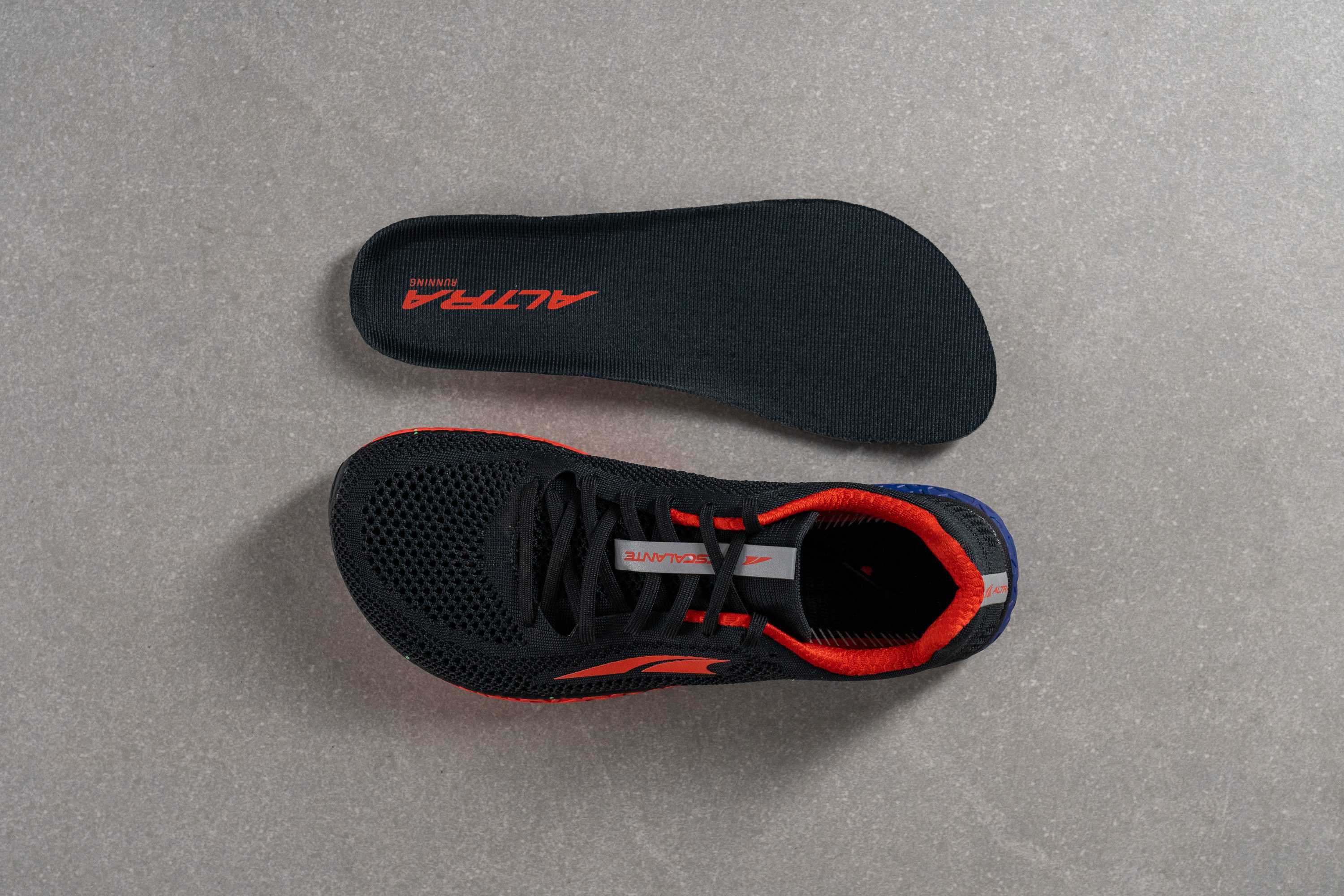
| Escalante Racer | Yes |
Midsole softness in cold (%)
This shoe isn't the best choice for winter due to its high breathability, but if you choose to wear it in colder weather, the good news is that the foam only becomes 19.9% firmer, which isn't too drastic.
However, remember it's wise to pair it with thick socks if it's really cold.
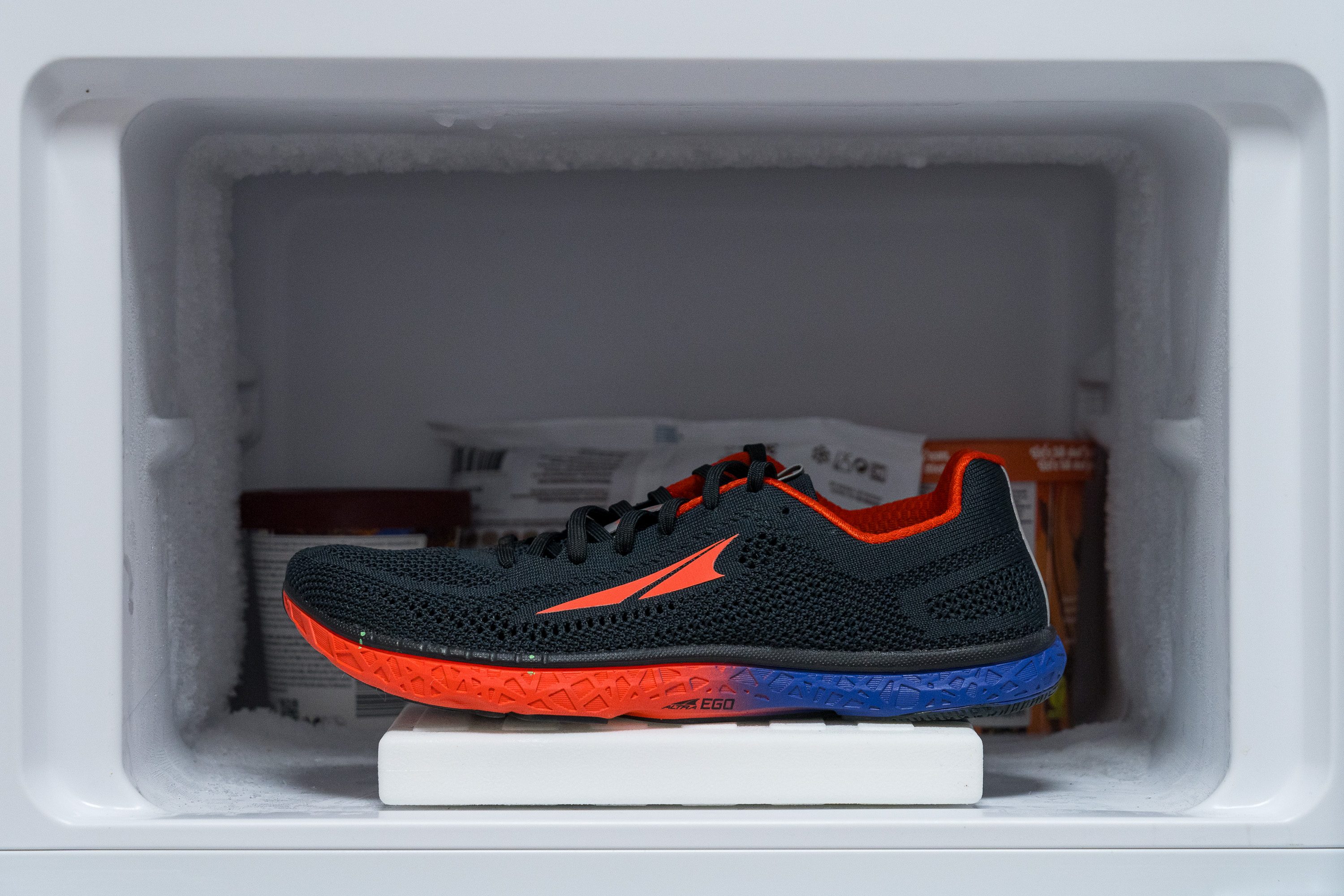
| Escalante Racer | 20% |
| Average | 24% |
Reflective elements
The Escalante Racer not only features reflective elements—we've observed that these are significantly more visible than the average ones we usually encounter in the lab. This is definitely a major plus for night runners!
| Escalante Racer | Yes |
Tongue padding
We've demonstrated that the Escalante Racer is crafted for lightness, and its tongue is no exception.
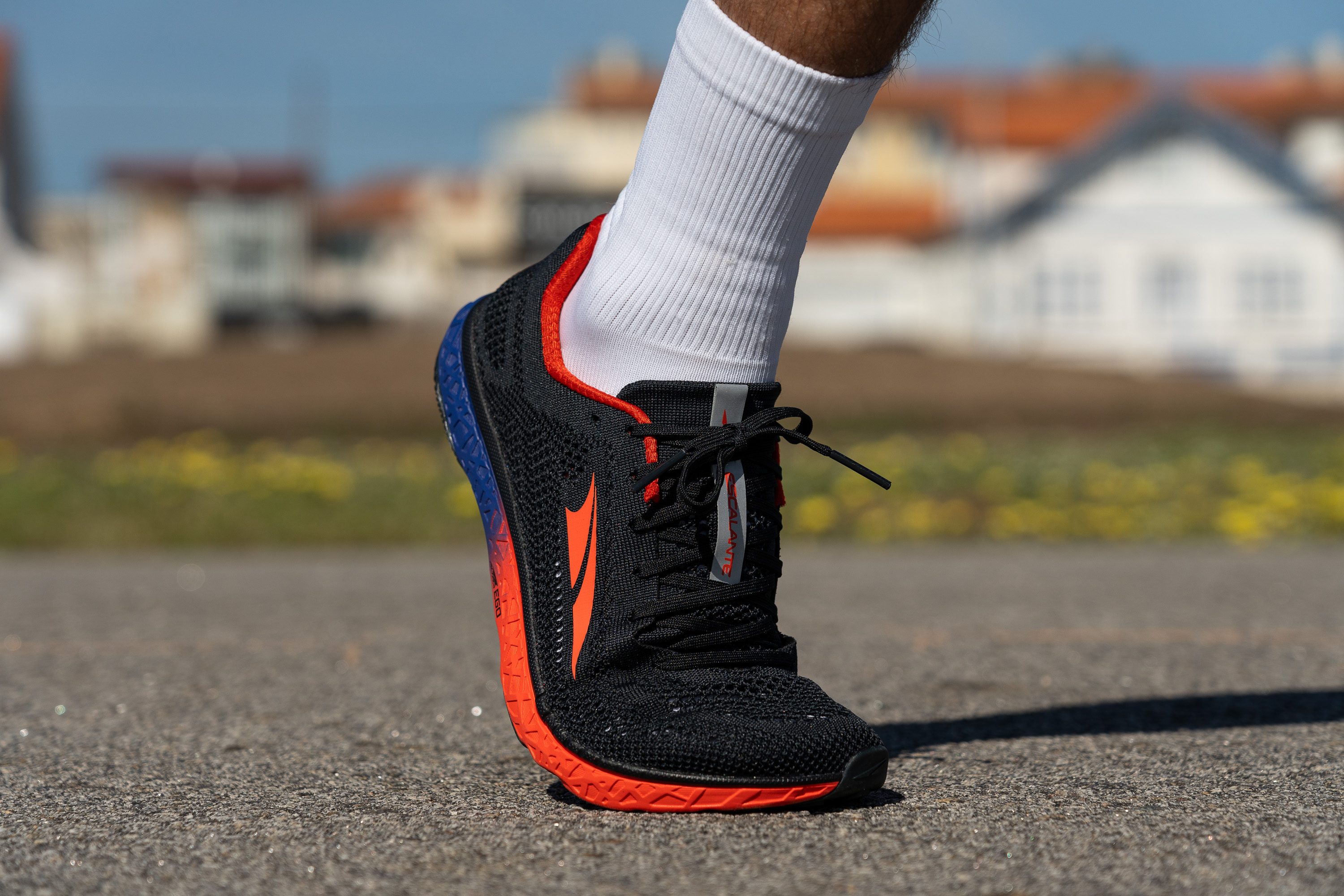
At just 3.1 mm, the padding provides sufficient comfort for your instep without adding unnecessary bulk. We believe this design balances minimalism with functionality perfectly.
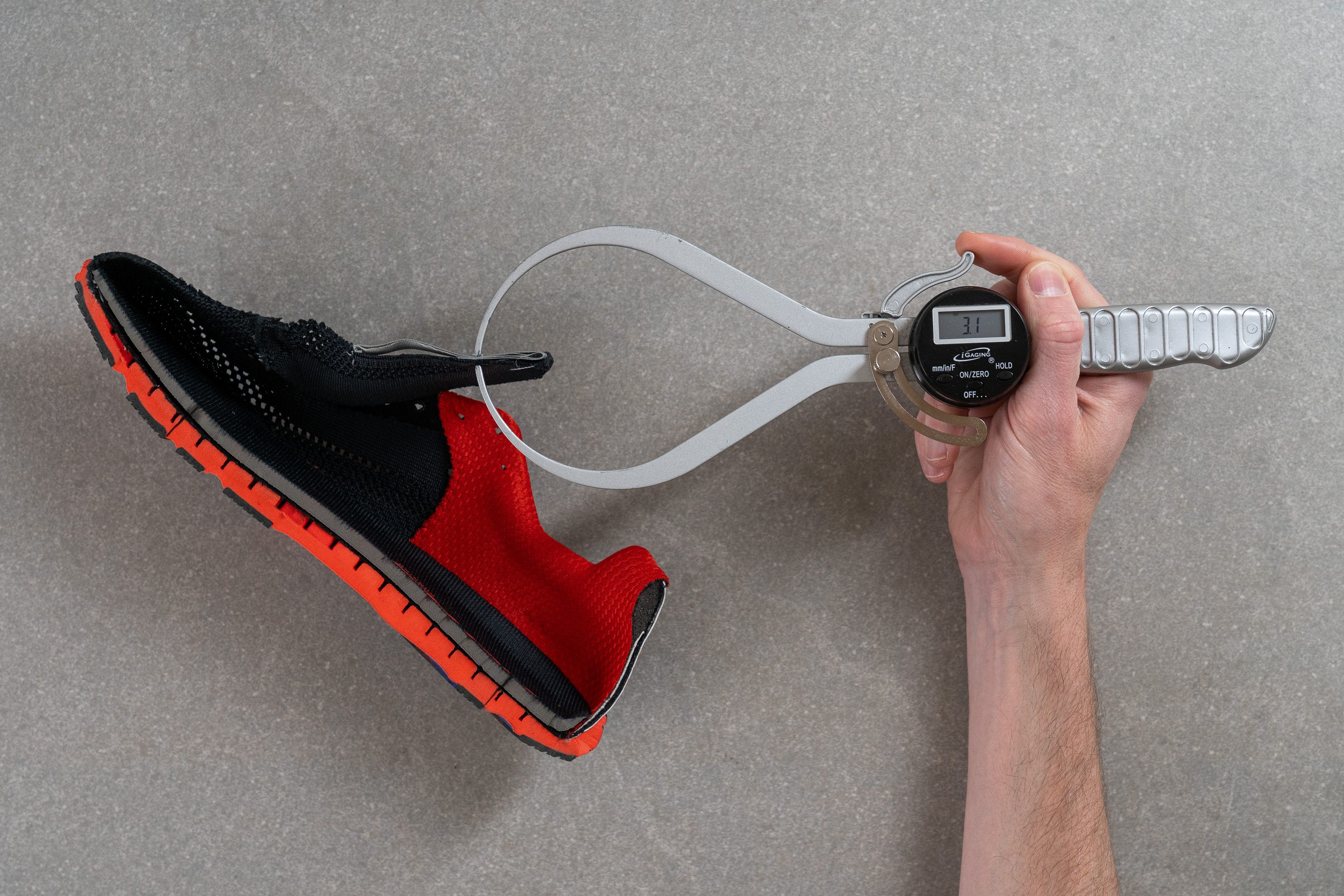
| Escalante Racer | 3.1 mm |
| Average | 5.8 mm |
Tongue: gusset type
Unfortunately, the Escalante Racer lacks a gusset, allowing the tongue to move freely. Although the lockdown isn't bad at all, we believe that adding at least a semi-gusseted tongue would have been beneficial, especially since this shoe is designed for faster paces.
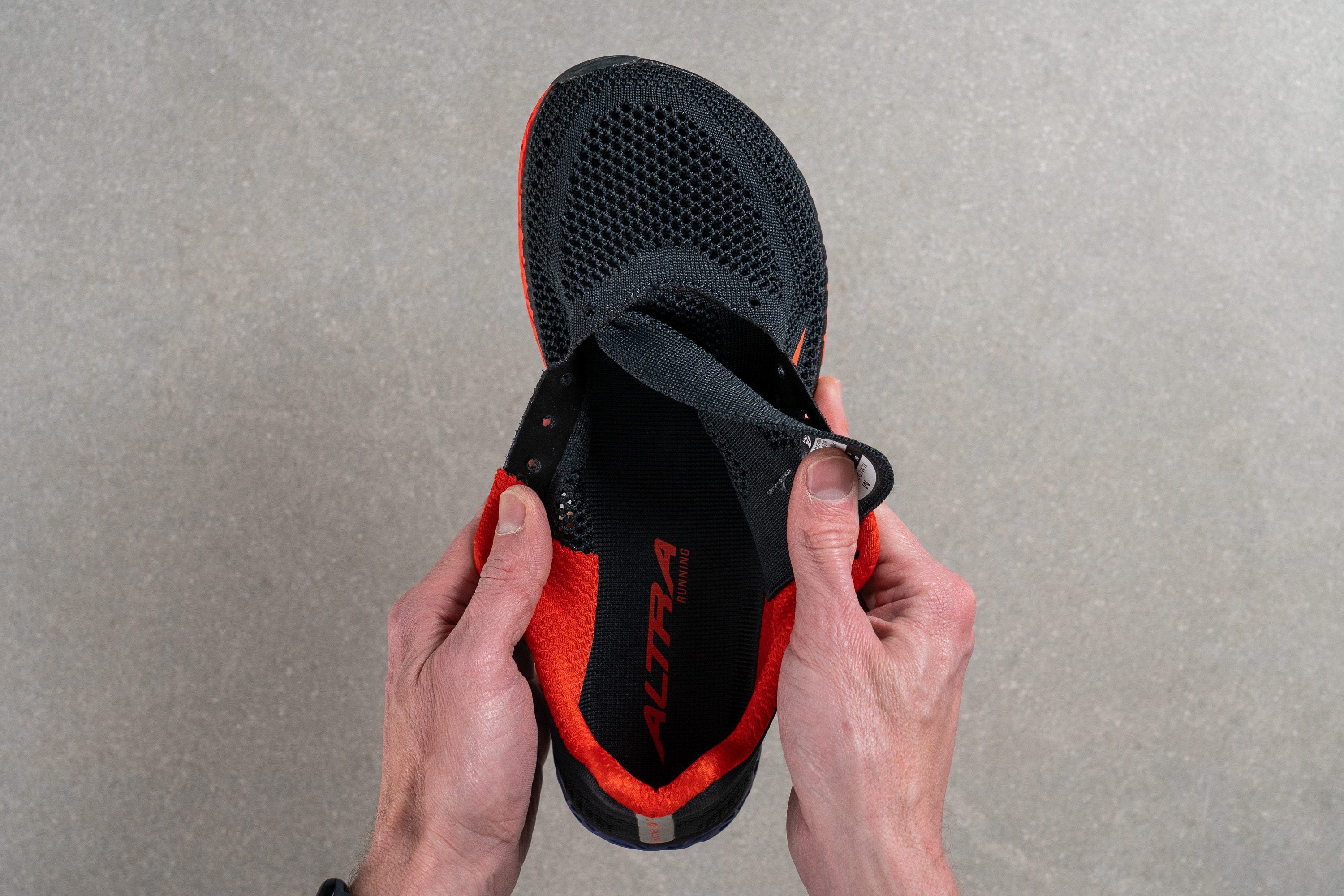
| Escalante Racer | None |
Heel tab
The Escalante Racer faithfully follows the familiar design elements of most Altra road shoes, which means it, too, omits a heel tab.
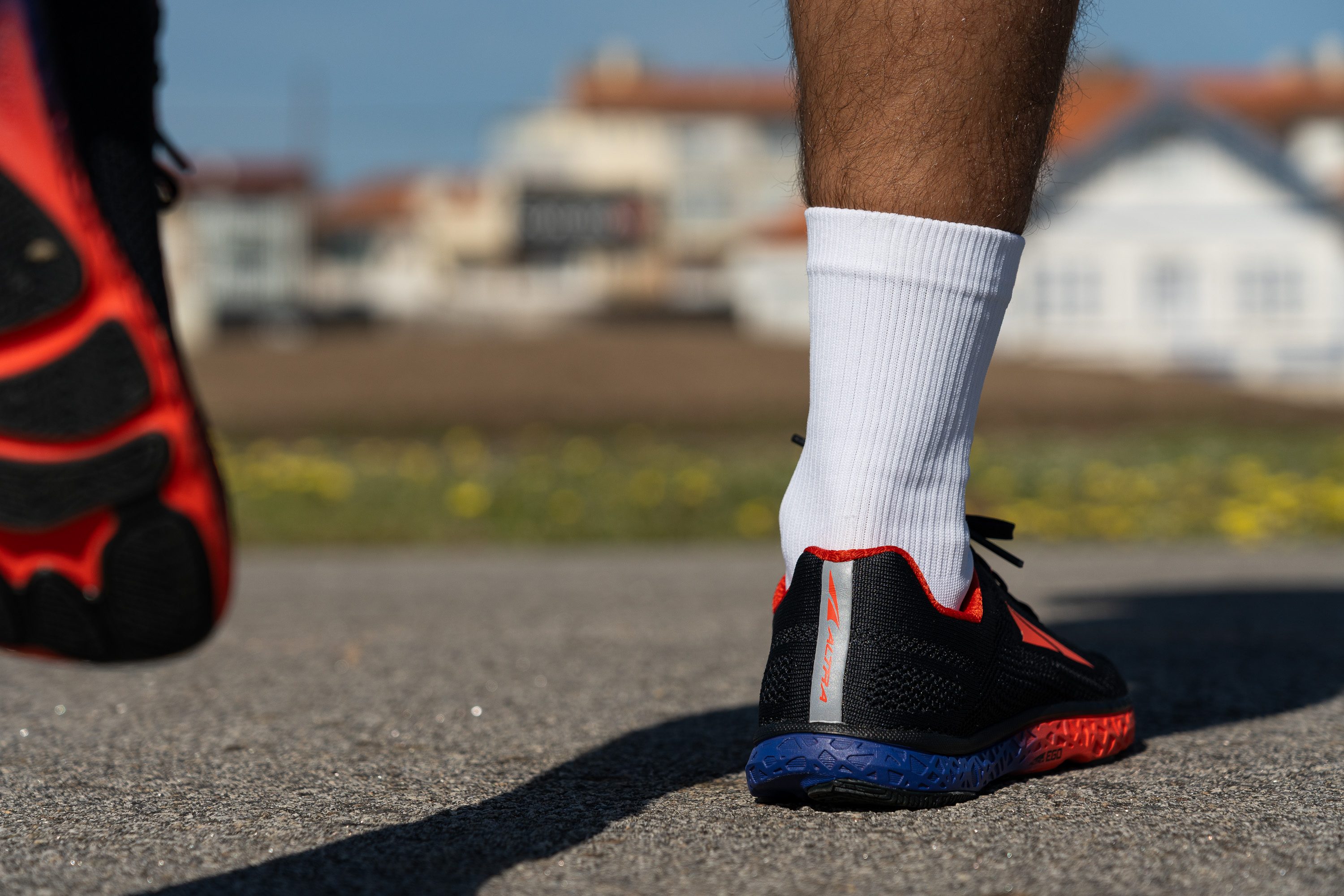
| Escalante Racer | None |

